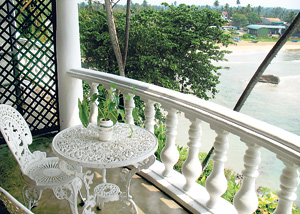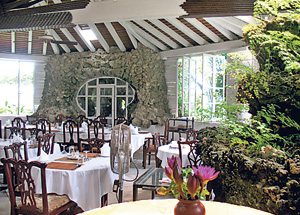I had forgotten about Closenberg. In the urge to discover new places to stay in and write about – in a search for the latest minimalist boutique villa or revived colonial bungalow – I had overlooked one of Sri Lanka’s most charming resort hotels.
So I was unprepared for the inimitable ambience of this hill top mansion, and for the flood of nostalgia that washed over me in waves as embracing as the surf breaking in the bay below.
Nostalgia? Yes, inspired by what Closenberg represents in today’s package tourist Sri Lanka: a genuinely traditional (and perhaps slightly eccentric) place to stay, governed by the family motto (not a copywriter’s spin) of ‘service to others comes first.’Closenberg is superbly situated three km east of the Unesco World Heritage site of Galle Fort, and four km west of the beach acclaimed (because of its bright beach life) as one of the world’s ten best, Unawatuna. The mansion is built on a promontory (originally an island) in the Galle harbour.
The Dutch in 1719 built a fortalice on what they called Klossenburg island, describing it as a citadel on which the sea roars. The Sinhalese referred to it as Aluth Kotuwa (New Fort) although it was abandoned when the British arrived in 1790.
In 1860, Captain Francis Bayley, the resident agent of the P & O shipping line, acquired the island and built his home, the Villa Marina, at its highest point, overlooking the sea. In 1889 it was sold to Simon Perera Abeywardene and has remained in the Perera Abeywardene family ever since.
In 1965 this family home became a hotel with the four main rooms set aside for guests and the former bachelors’ quarters becoming the kitchen.
A block of 16 rooms facing the sea was added in 1983, which is when I first visited. It was wonderful to discover last month that nothing much has changed since then, although air-conditioning of the new rooms was added in 2003.
The approach is up an unmarked lane at the eastern side of the well-guarded entrance to the port.
At the top, the lane leads under a narrow portico that was once the main entrance but the doors have been closed for more convenient access at the front, where there is space for cars to park.
 |
| A room balcony with a view of the sea |
 |
| The Fernery Restaurant: Good food in addition to unique design |
Guests step up to the verandahs that sweep around the house, below rafters bedecked with the rising sun motif of the old P & O line.
Huge wooden doors are kept open so the chandeliers hanging in the rooms, clad in heavy wooden panels, reflect the mansion’s history.
Those four rooms are still used as bedrooms when requested by British guests who relish sleeping in rooms that have a link with the past.
The sea-facing rooms have assumed their own character with balustraded balconies and a pleasing intimacy. The beds have soft, comfortable pillows and sheets of 100% fine cotton sourced from a Sri Lankan company appropriately known as Legacy Linen.
There are gardens and terraces, alcoves and secret nooks and crannies galore, and a rock pool at the water’s edge below. Under the managing director, G. K. P. Abeywardene, representing the fourth generation of the owning family, Closenberg is inspiring in the way tradition has kept pace with modern trends.
The Fernery Restaurant, distinguished by a permanent rock garden of ferns, and rafters with the ubiquitous rising-sun motifs, not only serves good southern rice and curry, but innovative modern cuisine on demand.
The staff match the hotel’s image, with discreet courtesy and individuality.
It’s easy to relax and let the charm of Closenberg cast its magic, harking back to the serendipity of Ceylon. It’s somehow fitting that the hotel’s website is spelt differently from its name. It’s odd, but indicates that there is nothing standardised about Closenberg. Forgotten it may have been, but its allure remains.
Closenberg Hotel, Galle; tel: 091 2224313 email: closenberghtl@sltnet.lk; www.closenburghotel.com |
